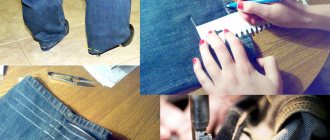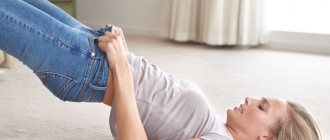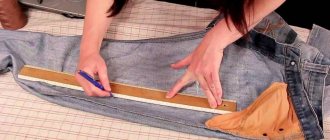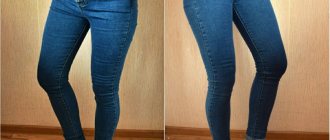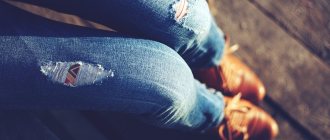You can cut and hem jeans in a tailor shop, but not every shop does it quickly, but you want to wear new jeans today. Trimming seems to be easy, if only you had good and sharp scissors, but how not to make a mistake with marking the shortening line? How to hem jeans, because hemming by hand with a blind seam is out of date. Is it possible to sew rough denim on a household sewing machine? And if you also want to preserve the beautiful factory hem seam, then you definitely can’t do it without consulting a master.
In this video you will learn how to hem jeans while maintaining the original seam.
In this article, the studio technologist shares his experience on how to properly cut and hem jeans, including preserving the factory seam. What is the difference between hemming women's jeans and men's jeans and how can you make shorts from old jeans?
In this video you will learn how to hem jeans using a sewing machine.
How to mark a hem line for jeans
If the jeans are too wrinkled, for example after washing, then the lower parts of the legs can be ironed. It will be easier for you to apply marking lines on a flat surface of denim.
Before cutting your jeans, you need to accurately determine the shortening line and the width of the hem. Many “folk” ways for this have been invented, including this unique one, standing on a chair. Although, why not, if it’s convenient for you?
In the studio, the required length of jeans is measured like this. The customer, in jeans and without shoes, stands on a mat near a mirror with an additional lower view. In this mirror he will be able to clearly see what the length of his jeans will be. The excess jeans are folded inward and pinned. The hem line should touch the floor on the heel side. If women's jeans are to be worn with heels, then the lower back of the jeans should be even lower.
After this, you need to stand in front of the mirror in the shoes in which you are going to wear jeans, and the length is already adjusted taking into account the height of the heel and the wishes of the customer.
The measurement is taken along one leg of the right leg, since the right leg is usually longer than the left. The adjusted hem line (with shoes) is marked with chalk along the back side in one or three places. There is no need to mark anything on the front.
Now, using these marks (tag), you need to draw a line around the circle of the trouser leg. This is done on the desktop, as shown in this photo, using a long ruler. Below this marking we set aside 3-3.5 cm and draw another line. This is where you will need to cut the right leg of your jeans.
Now you can trim off the excess part of the right leg of your jeans with large tailor's scissors. Just don’t forget about the hem allowance. Half the work is done, the left half remains, well, everything seems simple here. Not at all, this is where the qualifications of a master are required.
Inexpensive jeans are sewn at the factory, without particularly checking the length of both legs. This is due to the technological features of mass tailoring. Therefore, half of the jeans have different lengths of both legs, albeit slightly, but they do.
Of course, in order to cut the second part, you need to fold the legs together (the back parts are inside) and mark a line on the second leg with chalk along the already cut part. But for some reason, when you note that everything seems to be perfectly straight, but in the finished form the jeans legs turn out to be different lengths.
Ways to shorten a pair of jeans
Most denim trousers have nice distressed seams, including at the hems. Keeping this part, when shortening, will make the hem less noticeable.
How to hem jeans and keep the factory seam
You can shorten jeans, just like in a tailor shop, while preserving the factory seams at home. All work takes place in several steps:
- Mark the new position of the bottom line with pins. Set aside an upward distance for the stitching, usually 1.5 cm, and draw a line from the wrong side. Divide the distance from the new hem line to the finishing stitch and draw a line from the wrong side. Do the same on the second leg.
- Iron the trousers along the last marked lines. Secure the bottom line with pins. This will allow you to stitch without moving one layer relative to the other. Particular attention should be paid to the side seams - they must match after stitching. If you are not confident in working with pins, you can sweep the bottom.
- Place a stitch 3-4 mm above the finishing stitch.
- Trim off excess allowance (anything larger than 1 cm) and overcast. You can use a zigzag machine stitch to finish the edge.
- Iron the seam allowance to the top.
- Sew a stitch on the front side, matching the thread to match the color of the jeans.
The result is a neat hem, the frayed edge is preserved, and the factory stitching is also in place.
Video of shortening while maintaining the seam
Shortening jeans by hand
You can shorten trousers without cutting the bottom without using a sewing machine. Girls often wear one pair with heels of different heights. If you need to wear long trousers adapted to high heels, you can hem them manually:
- Mark the hem line with tailor's chalk.
- Iron seam allowance inside out.
- Turn the trousers inside out and sew the bottom of the trousers to the side seams using neat small stitches.
The hem is temporary, without finishing stitching, but in some situations it helps a lot.
Video: shortening jeans manually
The fastest way
The method can be used in rare cases when it is not possible to use a sewing machine. From the materials you should prepare Moment glue and an iron.
- After trying on, draw the lines of the bottom, the bend of the bottom and cut off the excess allowance.
- Using the minimum required amount of glue, glue the seam allowance along the first fold line and iron it.
- And also glue the folded edge along the marked bottom line and fix it with the pressure and temperature of the iron.
The processing is not particularly beautiful, but in conditions of lack of time and conditions it will help out.
Hem the bottom using a zipper
A badly frayed bottom can be revived with zipper tape. Used zipper tape will do. It is only necessary that the teeth be metal.
- Open the hem stitch. Iron the seam allowance.
- Adjust the zipper to the seam allowance, the teeth should protrude beyond the bottom line.
- Sew the finishing stitch, catching the braid.
The treatment looks stylish and strengthens the hem of the trousers.
Fast and beautiful - double hem plus homemade “factory” stitching
On black jeans or just plain indigo, you can make a hem without saving the old “factory” stitch. To work, you need to choose thread No. 20 in the color of the trouser trim.
Important! Most home sewing machines do not sew with thick thread when threaded into the needle. In this case, the thread is wound onto the bobbin.
- After fitting, draw a new hem line from the front side.
- Down you need to set aside 1.5 cm and 3.5 cm. Draw two lines - the bend of the hem allowance and the line along which the excess allowance will be cut off.
- The double hem can be pressed or hemmed by hand.
- In places of thickening opposite the side seams, you can cut off the internal allowance and beat the seam with a hammer.
- The finishing stitch is laid from the wrong side. The finishing thread is threaded into the bobbin, the stitch is at maximum.
Finishing stitching is done using this method quickly, simply, beautifully and is not much different from the factory one.
Hem the bottom using trouser tape
A method that is suitable for both wool and denim trousers. In advance you need to select a trouser braid of a suitable color and thread for the finishing stitch.
Important! Cotton trouser tape shrinks greatly when washed; it must be wet and dried before use.
- Try on the jeans and pin them to the correct length.
- Mark a new bottom line with chalk, set aside 2 cm and 1.5 cm from it, and also draw lines.
- Cut off all excess, leaving a 3.5 cm allowance.
- Baste the trouser tape to the hem allowance. The thickened edge of the braid coincides with the bottom line.
- Sew the braid in two parallel lines.
- Press the seam allowance up and press the hem.
- Sew a finishing stitch on the reverse side. In this case, a blue thread is threaded into the needle, and a finishing thread of greater thickness is wound in a bobbin.
This is interesting: Fitness, what is it?
The trouser braid gives the fabric density, the jeans are worn for a long time and do not fray.
Creative hem
Youth and children's jeans are hemmed using finishing elements:
- Various materials are used as finishing and simply to lengthen the jeans: genuine leather, denim of a different color.
- The stitching seam of an extension extension made of another material can be decorated with your own embroidery.
- You can form cuff cuffs from plaid fabric and use colored fabric for the pocket edging.
A carefully executed hem, while maintaining the hemmed edge, allows you to perfectly fit expensive jeans, while a creative hem gives a second life to your favorite pair, and is liked by your family and those around you. A simple job of repairing and adjusting denim pants can lead to a future sewing hobby.
Before cutting jeans, you need to align both legs
To avoid this, you need to carefully check the length of all lines of the side seams, internal seams, and waistband. You need to fold the jeans not along the front, but along the back, carefully smoothing out the folds with your palm. It doesn’t hurt to fasten the button and be sure to match the line of the belt; you can even pin the folded belt together with pins. Make sure that all the lines match, and only then cut off the second leg of the jeans with scissors. If it doesn’t work out exactly the first time, you can redo it and adjust the length during the fitting.
Fold the jeans together, smooth out all the wrinkles with your hand, and along the cut of the right leg, mark a cutting line for the left side of the jeans. The hem line should be perpendicular to the side seam of the jeans. No “bevels” should be made, otherwise the hem will not lay out nicely, pulling the front part of the fabric inward. Hem allowance: 3-3.5 cm for regular thickness denim and 4 cm for thick (winter) fabric with pile.
Turn the pant leg over and continue the hem line on the reverse side with chalk.
Now you can trim the left side of the jeans.
Be sure to mark the hem lines as you will need to press the double hem along them. By the way, there is no need to use chalk; soap is better suited for marking; after ironing, traces of soap can be easily removed, but chalk traces can sometimes remain and be difficult to remove. We used chalk so that you could better see these lines in the photo.
Preparing the hem of jeans
Now you need to iron the hem with an iron, as shown in these photos. First, roll up the jeans the full width of the hem in a circle and fix with a hot iron and steam.
Then fold the ironed hem halfway and also iron it along the circle of the trouser leg. Try not to touch the iron to the previous ironed line.
Iron the folded double hem well and you can begin processing the hem on the sewing machine.
Correctly marking the length
There is no point in adjusting the length based on an old pair of trousers. Pants become deformed during wear, and even if both pairs are the same size and model, they may fit differently when worn.
New jeans are worn with a belt and shoes. It’s good if there is a large mirror in the house, you need to look at yourself from the side so that the length of your trousers in front and behind are clearly visible.
How to hem jeans correctly
Turn the jeans inside out, as it is better to hem jeans at home on the wrong side.
After ironing the double hem of your jeans with a steam iron, baste it with thread or pin it with tailor's pins. But now you can hem your jeans, of course, on a sewing machine and always with threads of the same color as those on the factory hem.
But first, tap the handles of the metal scissors on these areas of the denim seams. Rough seams, even those with several folds, cannot be sewn by a household sewing machine. True, if you tap them with a hammer or scissors, these areas will soften a little. But, nevertheless, you cannot hem jeans using a household sewing machine. This requires an industrial sewing machine or a manual Podolsk type machine, but more on that below.
How to choose hem threads
Buy thread of regular thickness. The main thing is that they match the color of the factory one and wind two threads on the bobbin at once, and you can leave the top (needle) thread alone, even of a different color.
It is better to buy threads based on the sample of the remaining trimmed parts with the preserved seam. They take up little space and you can't go wrong with the color when purchasing. You can buy threads in advance when purchasing jeans. But don't use the same thick thread on your sewing machine that was used to hem your jeans at the factory. She still won’t sew with such threads, unless you have a class 22 industrial sewing machine with a No. 130 needle, but the machine can be damaged.
You need to hem the jeans along the inside of the leg, as shown in the photo, then the double thread in the bobbin will be on the front side. It is quite difficult to stitch exactly on the wrong side, but the fit will be pushed inward when sewing, and the seam will look neater on the right side. Be sure to fix the hem with a steam iron and sew it tightly with contrasting threads, since you may have to undo the stitching more than once and make a new seam.
Required tools and materials
The decorative seam along the bottom of the legs serves as decoration for the jeans, so when shortening you want to preserve the finish. Before work, you need to remember that an incorrectly measured length of 1-2 cm can disrupt the style of the trousers. To accurately hem jeans, you will need the following tools and materials:
- sewing machine for stitching on thick fabric;
- needles for processing denim material;
- measuring tape, chalk (soap marker);
- tailor's scissors or regular ones with a sharp edge;
- pins, thick threads to match the stitching of the pants;
- threads to match the color of the jeans for unnoticeable hemming.
Experts recommend measuring strictly along the right leg. Then you should carefully align the jeans - lay the item on a flat table surface, fold it inside with the legs, align it along the side seams, belt line, pockets and inner seam. There should be no folds or distortions on the fabric.
This is interesting: Dishes for the New Year's table
How to cut jeans correctly and not disturb the decorative appearance of the bottom of the trousers: first, try on the jeans, mark the hem and tuck them, and try them on again with the shoes. Then the right trouser leg is trimmed, the fitting is performed again and the left trouser leg is shortened. Before making a machine seam, the hem line is basted with contrasting threads.
Sewing machine for hemming jeans
If you have an old Podolsk or Singer manual sewing machine in your closet, then you can use such a sewing machine to hem jeans. You certainly won’t break anything on it, except maybe the needle. But even such a sewing machine has difficulty sewing rough areas of jeans and can break the thread and break the needle.
Before hemming your jeans using a machine, tap the seams with a hammer to soften them a little. You can even rub the top thread with a bar of soap. Sew slowly, stitch by stitch, helping the machine with your hand. See also Decorative stitching on a difficult area. We strongly do not recommend sewing rough jeans on modern household machines. If you don’t have a Singer or Podolsk type machine, then it will probably still be cheaper to cut and hem your jeans in a studio.
This video shows a way to hem jeans using trouser tape. This method allows you to maintain the length of the trouser leg and reliably protect the hem of your jeans from rubbing out.
How to cut jeans while maintaining the factory hem seam
It is necessary to preserve the finishing stitch when the denim fabric has a special treatment. Or in the case when the new seam does not match the finishing decorative stitches of the jeans. In all other cases, it is better to hem as expected.
Trimming jeans while maintaining the factory hem seam is fairly easy. The main thing is to calculate exactly how many centimeters to shorten the jeans, take into account the seam allowances (1.5 cm) and carefully, close to the line of the factory seam, first sweep and then sew the cut off areas on the wrong side.
The photo clearly shows how to hem jeans while maintaining the factory seam. After joining, the cut edges of the jeans must be processed with an overlock, zigzag, or hand-stitched.
Video on how to make shorts from old jeans.
Hemming trousers using adhesive tape
An excellent tool if you need to shorten jeans is adhesive tape. It allows you to achieve the desired length without cutting the bottom.
Sewing adhesive tape is a unique subtype of double-sided tape, which, when heat treated, is converted into glue and allows you to reliably connect two pieces of fabric. Moreover, the temperature required to achieve success can be achieved without problems using a standard iron with a steamer.
Procedure:
- Find special adhesive tape in the store and purchase it. It is usually sold by the meter, so you can take some stock.
- Mark the jeans along the length.
- Place the tape between the layers of folded fabric.
- Iron the material using the steam function. To ensure the safety of the material, an intermediate damp cloth can be used. It is very important to apply high pressure to the surface to melt the tape and connect the fabric elements.
- Give the product some time to cool, then check the strength of the connection.
It is worth noting that the final result directly depends on the quality of the adhesive base, the pressing force and the characteristics of the particular jeans.
